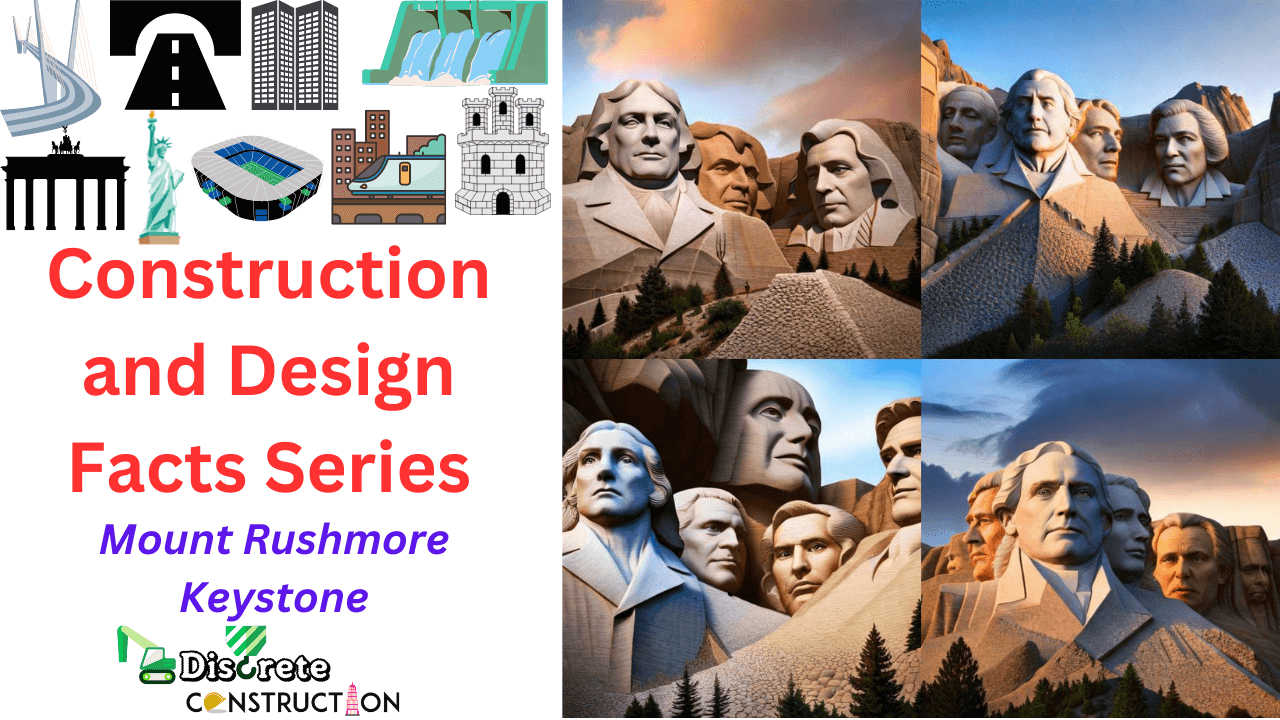Carved into the rugged landscape of the Black Hills in Keystone, South Dakota, Mount Rushmore National Memorial is a masterpiece of art, a feat of engineering, and a tribute to the indomitable spirit of America. This monumental sculpture, chiseled into granite, exemplifies the essence of American patriotism and stands as a testament to the nation’s rich history. Comprising the 60-foot high faces of four iconic U.S. Presidents – George Washington, Thomas Jefferson, Theodore Roosevelt, and Abraham Lincoln – this awe-inspiring sculpture continues to fascinate scholars, tourists, and patriots alike. It stands not only as a marvel of design and construction but also as a symbol of America’s enduring values.
The construction of Mount Rushmore was a gargantuan task, with challenges of unprecedented scale and complexity. From the initial conceptualization to the moment the final chip of granite was removed, it demanded an innovative combination of artistry, engineering, and sheer physical labor. More than just a depiction of four revered leaders, it stands as a testament to the immense efforts of countless craftsmen, miners, and engineers, who braved the elements and the heights to shape a memorial that would stand the test of time.
Gutzon Borglum, the visionary behind this monumental project, embarked on a journey that many deemed impossible. Undeterred by the daunting magnitude of the task, he marshaled a team of over 400 workers and embarked on a 14-year long endeavor. The sculpting process involved not just traditional tools such as jackhammers, chisels, and drills, but also dynamite, serving as a vivid testament to the project’s scale. The use of these varied tools highlights the incredible blend of delicate artistry and robust construction practices employed at Mount Rushmore.
Yet, the creation of Mount Rushmore was not merely about carving faces into a mountain. It required an extensive understanding of the material – the hard, coarse-grained granite. The choice of this material ensured the longevity of the monument, with the granite estimated to erode only 1 inch every 10,000 years. Detailed geological surveys were conducted to understand the granite’s structure and composition, further exemplifying the intricate planning and technical precision required in the project’s execution.
Furthermore, the project demanded sophisticated logistical coordination. The remote location and the scale of the monument required on-site housing for workers, food, and medical facilities, and a specially designed tramway system to ferry workers and supplies up the mountain. On the technical front, Borglum used a revolutionary method called ‘pointing’ to translate the scaled-down models onto the mountain’s face accurately. These efforts collectively showcase the ingenious blend of engineering, logistics, and design involved in creating Mount Rushmore.
Mount Rushmore’s construction also underscored an impressive commitment to safety. Despite the project’s inherent risks, not a single life was lost, a remarkable achievement considering the nature of the work and the era’s safety equipment. The workers, many of whom were miners, were trained to evacuate quickly in case of falling rocks, and harnesses were used to ensure their safety while working at towering heights.
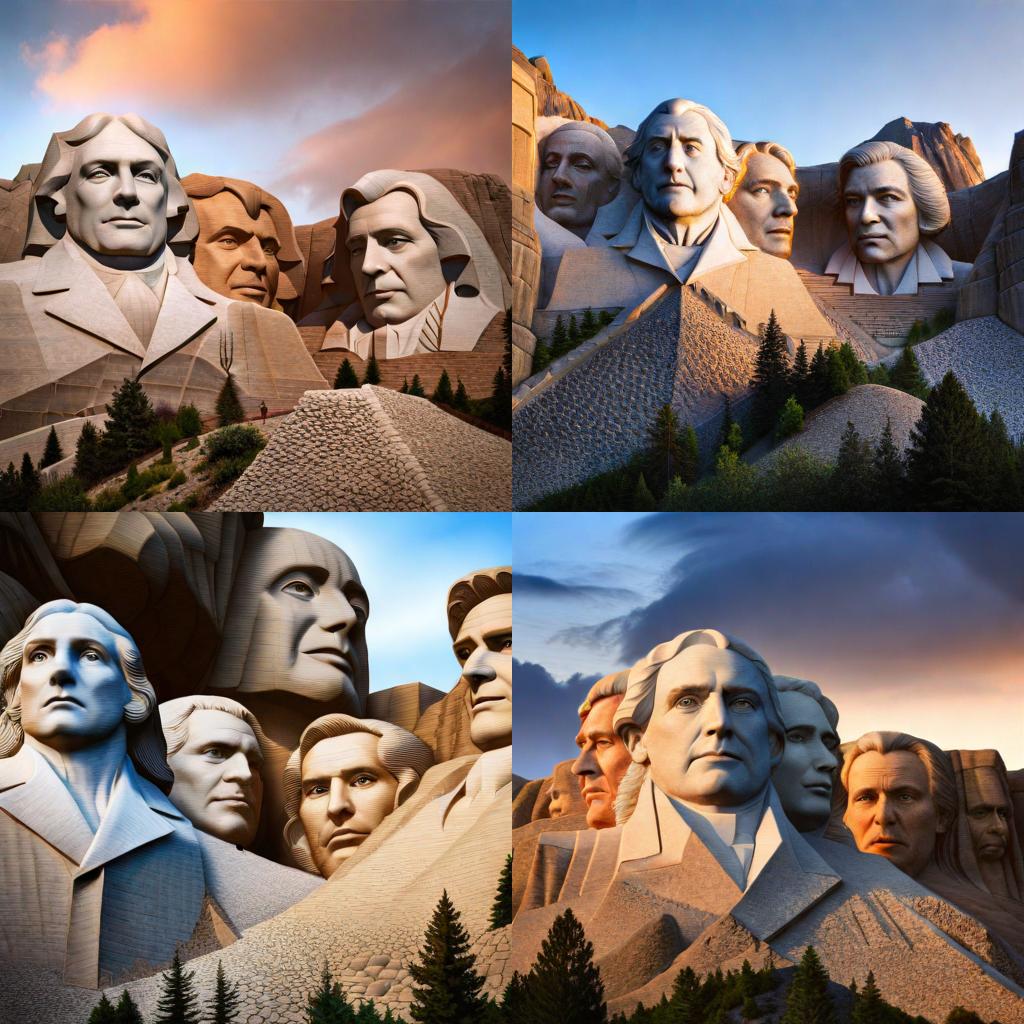
In addition to its scale and engineering feats, Mount Rushmore’s design also tells a compelling story. Each of the four presidents was chosen for their significant contributions to the country: Washington for the nation’s birth, Jefferson for its expansion, Lincoln for its preservation, and Roosevelt for its development. These design choices, beyond their artistic and aesthetic considerations, reflect a deep appreciation for American history and its fundamental principles.
This article delves deeper into these intriguing facets of Mount Rushmore, exploring the top 50 construction and design facts that make it an astonishing architectural feat. From the strategic use of dynamite to carve the granite, the intricacies of ‘honeycombing’ technique, to the rigorous safety measures put in place, this iconic American landmark’s construction process offers a wealth of knowledge and insight. It stands as a monument to human ingenuity, creativity, and the perseverance of the American spirit.
In understanding the fascinating facts behind its construction and design, we celebrate not just the monumental sculpture but also the technical achievements, meticulous planning, and immense hard work behind it. Let’s journey through the history of Mount Rushmore’s creation and delve into the details of the audacious project that carved history into the heart of the Black Hills.
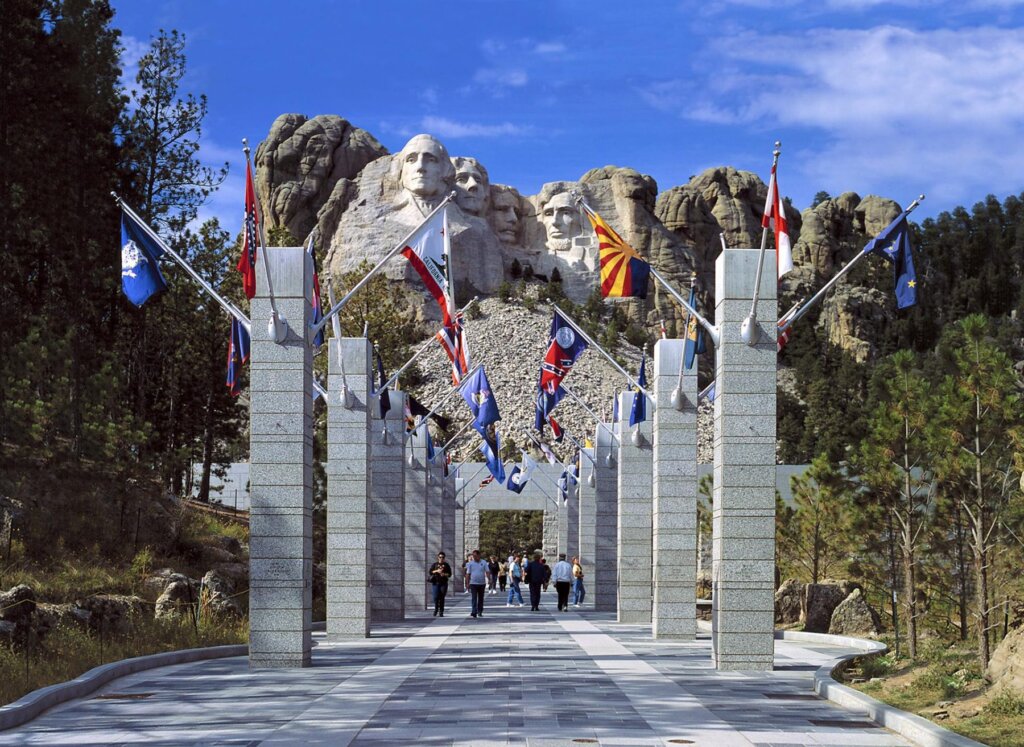
Top-50 Facts of Mount Rushmore
- Mount Rushmore National Memorial, located in Keystone, South Dakota, represents a significant achievement in the field of construction and design.
- The colossal structure was built to honor four U.S. presidents: George Washington, Thomas Jefferson, Theodore Roosevelt, and Abraham Lincoln.
- Designed by sculptor Gutzon Borglum, the construction began in 1927 and officially ended in 1941.
- The carved faces on Mount Rushmore are each about 60 feet tall, symbolizing the monumental influence these presidents had on the country.
- The entire Mount Rushmore project cost about $989,992.32. In today’s money, this amount would equal over $15 million.
- Borglum, a genius in large-scale sculpture, utilized a process called “honeycombing” to create the faces.
- Honeycombing involves drilling closely spaced holes into the rock, which are then removed in a single piece, making the removal process more efficient and less damaging to the remaining structure.
- Despite its grandeur, the initial design of Mount Rushmore was much more elaborate, intended to depict the presidents from head to waist.
- However, due to budget constraints and unpredictable weather, the design was scaled down to feature just the heads of the presidents.
- No fatalities were reported during the construction of Mount Rushmore, a testament to the careful planning and strict safety measures applied in the process.
- The workers had to endure extreme weather conditions ranging from harsh winters to sweltering summers.
- In total, about 450,000 tons of rock were removed from Mount Rushmore during its construction.
- A system of tramways and winches was set up on the mountainside to transport workers and equipment, showcasing advanced engineering solutions of the era.
- Dynamite was the primary tool for carving, used to remove approximately 90% of the unwanted rock.
- Precision was paramount: calculations had to be made to ensure that a single misplaced dynamite blast didn’t ruin the whole project.
- Once the bulk of the rock was removed, workers used smaller tools, like drills and chisels, to bring out the finer details.
- To protect the monument from erosion, silicon sealant is applied periodically to fill in cracks caused by the expansion and contraction of the granite.
- Mount Rushmore is designed with an impressive drainage system to divert rainwater, preventing erosion from water runoff.
- The construction team was composed of over 400 workers, many of whom were miners from the nearby area who had been laid off during the Great Depression.
- Gutzon Borglum used a large-scale model of Mount Rushmore, and a system called ‘pointing’ to ensure accuracy in translating the design from the model to the mountain.
- ‘Pointing’ is a system where coordinates are measured on the model, then magnified onto the mountain using a device known as a ‘pointing machine.’
- The construction team was well aware of the importance of their task, with Borglum often reminding them they were not just carving a mountain, but creating a national memorial.
- Borglum’s son, Lincoln, took over the project after his father’s death in March 1941 and saw it through to its completion later that year.
- The monument was strategically placed on Mount Rushmore due to its maximum sun exposure, ensuring optimal lighting on the faces throughout the day.
- Borglum initially started carving Thomas Jefferson’s face to George Washington’s right but soon realized the granite was flawed. He then dynamited the incomplete sculpture and started anew to Washington’s left.
- Tools like jackhammers, hand drills, wedges, and shovels were used in the process, showcasing the versatility of construction techniques at the time.
- Mount Rushmore required the removal of a substantial volume of rock, but every bit was repurposed or left in place as a part of the ‘talus slope,’ a feature at the base of the mountain.
- Despite the risky nature of the construction, workers were equipped with safety harnesses and were trained to quickly evacuate in the event of falling rocks.
- This project was a triumph of not just construction but logistics as well. Resources had to be managed efficiently as the site was remote and difficult to reach.
- A staircase of 506 steps was constructed to assist workers in reaching various parts of the mountain during the carving process.
- Borglum had initially planned to carve a brief history of the United States into the monument, known as the Entablature, but this idea was eventually scrapped due to lack of funding.
- All the dynamite used in the project was manufactured onsite in a structure known as the Powder House, demonstrating the team’s self-sufficiency.
- The sculpture was designed to face southeast to take advantage of the sun’s rays for the most extended period, maximizing natural illumination.
- Despite the grand scale of the project, the faces are detailed enough that you can even see Abraham Lincoln’s mole!
- The workday for a typical Mount Rushmore worker began at 7:30 AM and ended at 4:30 PM, with a half-hour break for lunch.
- The workers were paid an average of $8 per day, which was a respectable wage during the time of the Great Depression.
- The workers were trained to use pneumatic drills, which used pressurized air to drive the drill bit into the granite, making for more efficient carving.
- During construction, the Hall of Records was intended to be a vault for American historical documents and artifacts. However, the hall was left incomplete due to lack of funds and Borglum’s death.
- Gutzon Borglum chose these four presidents because he felt that they represented the most important events in the history of the United States.
- Washington represented the birth of the United States, Jefferson the growth, Lincoln the preservation, and Roosevelt the development of the country.
- The workers used a special pointing technique, using a grid system to enlarge the designs for the monument to scale.
- Despite being made of stone, the faces on Mount Rushmore were designed to display distinct expressions, capturing the character of each president.
- To ensure accurate carving, Borglum and his team made plaster models of the presidents’ faces, allowing them to study their subjects in detail.
- During construction, workers would often climb over 700 steps daily to reach the top of the mountain, showcasing their dedication and physical resilience.
- The project, funded primarily by the federal government, symbolized a nationwide commitment to preserving and celebrating American history.
- The monument’s location was also carefully chosen for its lack of nearby modern development, ensuring the natural beauty of the area would not be compromised.
- The granite chosen for Mount Rushmore is estimated to erode only 1 inch every 10,000 years, demonstrating the foresight in the monument’s design for longevity.
- The scale of the monument required the development of a unique system of pulleys, scaffolding, and tramways to transport workers and materials up the mountain.
- The sculpture’s immense size also required workers to live nearby, leading to the establishment of a camp at the base of the mountain, complete with dining facilities and a medical office.
- Ultimately, the construction and design of Mount Rushmore not only represented a significant technical achievement but also served as a symbol of national pride and a testament to the perseverance of the humanspirit.
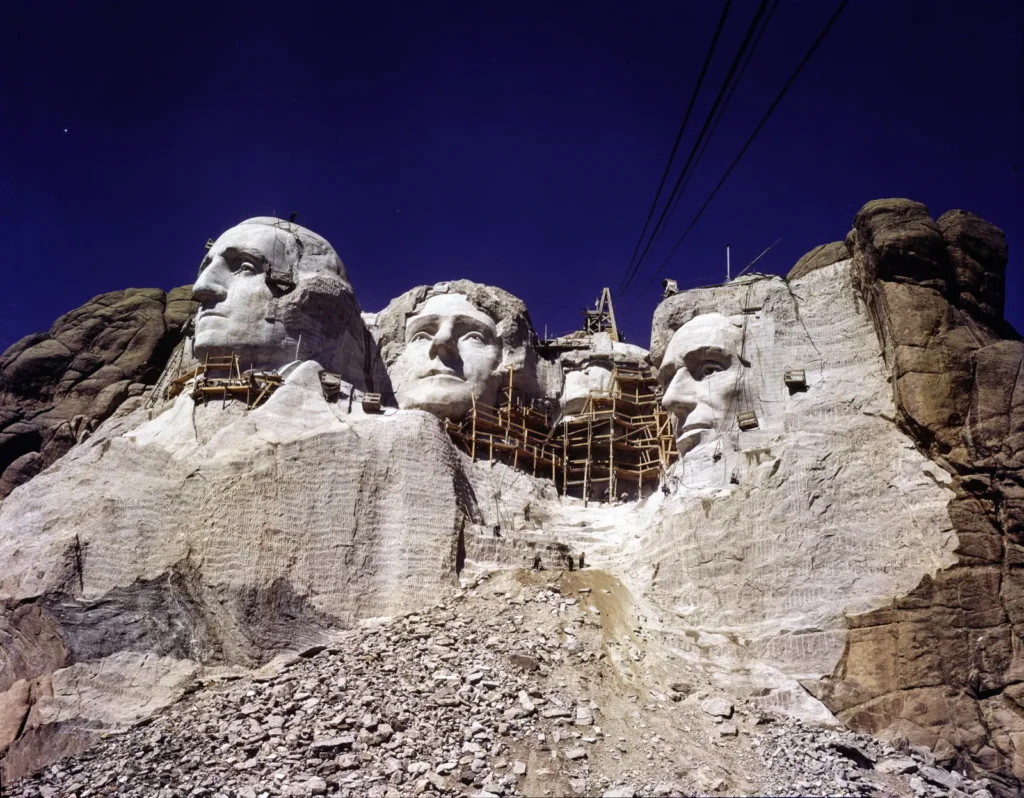
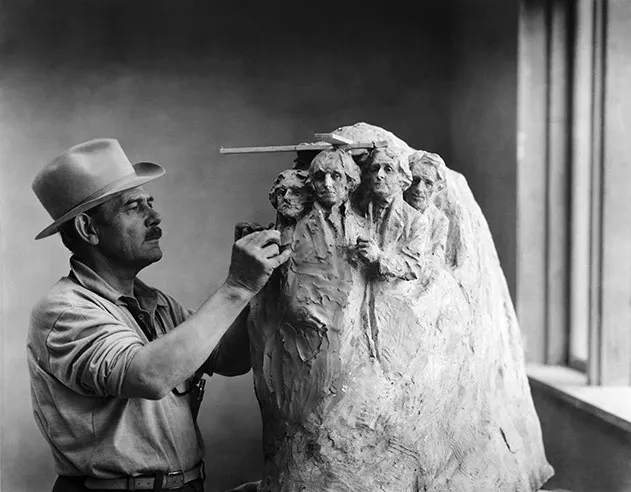
FAQ’s
Who designed Mount Rushmore?
Mount Rushmore was designed by Danish-American sculptor Gutzon Borglum.
How long did it take to carve the Mount Rushmore?
The carving of Mount Rushmore took about 14 years. It started in 1927 and was completed in 1941.
How were the presidents chosen for Mount Rushmore?
The four presidents carved into Mount Rushmore were chosen by sculptor Gutzon Borglum for their leadership during four significant periods of American history.
How was Mount Rushmore carved?
Mount Rushmore was carved using dynamite for a majority of the work, removing approximately 90% of the rock. The remaining details were achieved with jackhammers and hand chisels.
Why was Mount Rushmore built?
Mount Rushmore was built to promote tourism in South Dakota and to celebrate and memorialize the history of the United States.
What kind of rock is Mount Rushmore carved into?
Mount Rushmore is carved into a granite cliff. Granite was chosen due to its durability and resistance to erosion.
What is the size of the Mount Rushmore sculpture?
Each of the president’s heads on Mount Rushmore is approximately 60 feet high. The entire monument covers about 5.17 square kilometers (1,278.45 acres).
How much did it cost to build Mount Rushmore?
The total cost of constructing Mount Rushmore was just under $1 million.
What does each president on Mount Rushmore represent?
Each president on Mount Rushmore represents a significant period of American history. George Washington represents the country’s birth, Thomas Jefferson represents the expansion of the nation, Abraham Lincoln symbolizes the preservation of the nation, and Theodore Roosevelt represents the development of the nation.
Was anyone injured during the construction of Mount Rushmore?
Surprisingly, despite the dangerous nature of the work, no workers were killed during the construction of Mount Rushmore.
Read More

